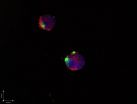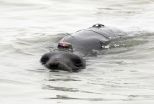Researchers engineer a 'smart bomb' to attack childhood leukemia
2014-11-05
(Press-News.org) Fatih Uckun, Jianjun Cheng and their colleagues have taken the first steps towards developing a so-called "smart bomb" to attack the most common and deadly form of childhood cancer — called B-lineage acute lymphoblastic leukemia (ALL).
In a November study in the new peer-reviewed, open-access journal EBioMedicine, they describe how this approach could eventually prove lifesaving for children who have relapsed after initial chemotherapy and face a less than 20 percent chance of long-term survival.
"We knew that we could kill chemotherapy-resistant leukemia cells if we only knew what made them so resistant. Once we determined the mechanism, the next step was obvious — to rationally design a drug that would take out that specific target," said Uckun, professor of research pediatrics at the Keck School of Medicine of USC and head of translational research in leukemia lymphoma at the Children's Center for Cancer and Blood Diseases of Children's Hospital Los Angeles.
The target of the "smart bomb" is a defective gene that results in the production of an abnormal form of the protein CD22, which causes cancer stem cells to proliferate and resist chemotherapy. This defective gene can thwart standard treatments for recurrent disease — including "supralethal" chemotherapy, total-body irradiation (TBI) and bone marrow transplantation.
Uckun's team designed synthetic pieces of genetic material, called RNAi, with the capability to shut down this defective gene. Then Uckun joined forces with Cheng, associate professor of materials science and engineering at the University of Illinois at Urbana-Champaign and an affiliate with the NCI Alliance for Nanotechnology in Cancer. Cheng's team engineered a small subunit of protein, called a polypeptide, to function as delivery system to send the RNAi to its target.
The resulting "smart bomb" has a diameter of only 100 nanometers, making it one of the new generation of nanomedicines that can target disease at a molecular level.
"The goal is to translate our recent research discoveries in nanotechnology and biotherapy into effective patient-tailored treatment programs for the most common form of childhood cancer," said Uckun, who is also a principal investigator with the university-wide USC Stem Cell initiative, bringing together more than 100 faculty members from all disciplines.
INFORMATION:
Uckun and his team were supported by funding from USC Stem Cell's Regenerative Medicine Initiative (RMI), a university-wide program kick-started by $1.2 million in funding from Carmen A. Puliafito, dean of the Keck School of Medicine of USC. The award facilitates collaborative interactions among the USC-based regenerative medicine community.
Additional funding came from DHHS grants P30CA014089, U01-CA-151837 and R01CA-154471 from the National Cancer Institute and the Director's New Innovator Award 1DP2OD007246-01 from National Institutes of Health. The Nautica Triathalon and its producer Michael Epstein, Couples Against Leukemia Foundation and Saban Research Institute Merit Awards also supported this work.
[Attachments] See images for this press release:

ELSE PRESS RELEASES FROM THIS DATE:
2014-11-05
The current Ebola outbreak shows how quickly diseases can spread with global jet travel.
Yet, knowing how to predict the spread of these epidemics is still uncertain, because the complicated models used are not fully understood, says a University of California, Berkeley biophysicist.
Using a very simple model of disease spread, Oskar Hallatschek, assistant professor of physics, proved that one common assumption is actually wrong. Most models have taken for granted that if disease vectors, such as humans, have any chance of "jumping" outside the initial outbreak area ...
2014-11-05
Researchers using a new type of tracking device on female elephant seals have discovered that adding body fat helps the seals dive more efficiently by changing their buoyancy.
The study, published November 5 in the Proceedings of the Royal Society B, looked at the swimming efficiency of elephant seals during their feeding dives and how that changed in the course of months-long migrations at sea as the seals put on more fat. The results showed that when elephant seals are neutrally buoyant--meaning they don't float up or sink down in the water--they spend less energy ...
2014-11-05
A University of Oregon researcher wants those "R" words to resonate among young athletes. They are key terms used in an online educational tool designed to teach coaches, educators, teens and parents about concussions.
Brain 101: The Concussion Playbook successfully increased knowledge and attitudes related to brain injuries among students and parents in a study that compared its use in 12 high schools with the usual care practices of 13 other high schools during the fall 2011 sports season. The findings are online ahead of print in the Journal of Adolescent Health.
Participants, ...
2014-11-05
A study led by a researcher from Plymouth University in the UK, has discovered that the inhibition of a particular mitochondrial fission protein could hold the key to potential treatment for Parkinson's Disease (PD).
The findings of the research are published today, 5th November 2014, in Nature Communications.
PD is a progressive neurological condition that affects movement. At present there is no cure and little understanding of why some people get the condition. In the UK one on 500 people, around 127,000, have PD.
The debilitating movement symptoms of the disease ...
2014-11-05
ANN ARBOR, Mich. — Millions of people with diabetes take medicine to ease the shooting, burning nerve pain that their disease can cause. And new research suggests that no matter which medicine their doctor prescribes, they'll get relief.
But some of those medicines cost nearly 10 times as much as others, apparently with no major differences in how well they ease pain, say a pair of University of Michigan Medical School experts in a new commentary in the Annals of Internal Medicine.
That makes cost -- not effect -- a crucial factor in deciding which medicine ...
2014-11-05
TALLAHASSEE, Fla. — A new study by a Florida State University researcher reveals that a new dietary supplement is superior to calcium and vitamin D when it comes to bone health.
Over 12 months, Bahram H. Arjmandi, Margaret A. Sitton Professor in the Department of Nutrition, Food and Exercise Sciences and Director of the Center for Advancing Exercise and Nutrition Research on Aging (CAENRA) at Florida State, studied the impact of the dietary supplement KoACT® versus calcium and vitamin D on bone loss. KoACT is a calcium-collagen chelate, a compound containing ...
2014-11-05
A child's ability to distinguish musical rhythm is related to his or her capacity for understanding grammar, according to a recent study from a researcher at the Vanderbilt Kennedy Center.
Reyna Gordon, Ph.D., a research fellow in the Department of Otolaryngology and at the Vanderbilt Kennedy Center, is the lead author of the study that was published online recently in the journal Developmental Science. She notes that the study is the first of its kind to show an association between musical rhythm and grammar.
Though Gordon emphasizes that more research will be necessary ...
2014-11-05
VTT Technical Research Centre of Finland has developed an innovative magnetometer that can replace conventional technology in applications such as neuroimaging, mineral exploration and molecular diagnostics. Its manufacturing costs are between 70 and 80 per cent lower than those of traditional technology, and the device is not as sensitive to external magnetic fields as its predecessors. The design of the magnetometer also makes it easier to integrate into measuring systems.
Magnetometers are sensors that measure magnetic fields or changes in magnetic fields. The kinetic ...
2014-11-05
Although gluten-free foods are trendy among the health-conscious, they are necessary for those with celiac disease. But gluten, the primary trigger for health problems in these patients, may not be the only culprit. Scientists are reporting in ACS' Journal of Proteome Research that people with the disease also have reactions to non-gluten wheat proteins. The results could help scientists better understand how the disease works and could have implications for how to treat it.
Armin Alaedini, Susan B. Altenbach and colleagues point out that celiac disease symptoms are triggered ...
2014-11-05
Photosynthesis is one of the most important processes in nature. The complex method by which all green plants harvest sunlight and thereby produce the oxygen in our air is still not fully understood. Researchers have used DESY's X-ray light source PETRA III to investigate a photosynthesis subsystem in a near-natural state. According to the scientists led by Privatdozentin Dr. Athina Zouni from the Humboldt University (HU) Berlin, X-ray diffraction experiments on the so-called photosystem II revealed structures which were yet unknown. The results are published in the scientific ...
LAST 30 PRESS RELEASES:
[Press-News.org] Researchers engineer a 'smart bomb' to attack childhood leukemia




